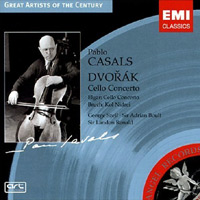 |
| March 15, 2005 Pablo Casals: Dvorák Cello Concerto
The HMV recording, produced by the legendary Fred Gaisberg, has been in virtually uninterrupted circulation since it first appeared on 78s. It came out on Victor in the US, and was reissued on an early RCA Victor LP; then, following the break-up of the long-standing trans-Atlantic affiliation, it turned up on Angel, the label on which HMV, English Columbia, and other EMI labels reached the US in those days. Early in the CD era, EMI brought it out in its French-produced "Références" series, together with Casals’s 1936 recording of Bruch’s Kol nidrei (with Sir Landon Ronald conducting the London Symphony Orchestra) and his 1945 Elgar Concerto (Sir Adrian Boult conducting the BBC Symphony Orchestra). Now the same three performances are offered again in the "Great Artists of the Century" series [EMI 62953]. As the unique status of this recording has been validated and revalidated for nearly 70 years, the only question raised by this latest reissue from the originating company is how it stacks up sonically against various others, from EMI itself and other sources. This edition comes with high expectations, based on the excellence of EMI’s latest treatment of another benchmark item in Casals’s discography, his contemporaneous recording of Bach’s six suites for unaccompanied cello [62617, two discs]. The Bach material had been brought out at least twice on CD by EMI itself, with unsatisfactory results in respect to sound quality. Later, though, the people in charge of the company’s "Great Recordings of the Century," perhaps shamed by superior results achieved by Ward Marston in his transfers for Naxos, applied their "Abbey Road Technology" and finally succeeded in producing a CD edition with the rich, lifelike sound old-timers remember from the 78s. Since the subsequent "Great Artists . . ." series also relies on "ART," it seemed reasonable enough to expect similar results from the new CD treatment of Casals’s Dvorák, and surely the murky “Références” edition, which involved the CEDAR system, wouldn’t be that hard to beat. In the event, however, there just isn’t that much difference. While the "Références" edition gave us a thin-sounding cello with a somewhat richer-sounding orchestra, the new one gives us the reverse; there is a tad more crispness, perhaps, but very little in the way of overall net improvement. No one would guess from either edition how full and robust the 78s sounded; it all comes off as simply a relic, a faded souvenir.
The companion work on Dutton is the fiery yet elegant performance of Dvorák’s final symphony, From the New World, again by Szell and the Czech Philharmonic, with no trace of EMI’s "ART," but actually recorded at Abbey Road in 1937. The Naxos discmate is the 1929 recording of Brahms’s Double Concerto with Casals’s own Barcelona orchestra and the two distinguished Frenchmen with whom he formed a trio in 1905 that played together for nearly 30 years. The violinist Jacques Thibaud is Casals’s fellow soloist, and the conductor is the trio’s pianist, Alfred Cortot. My own preference is for the Dutton, but both of these transfers are so much more appealing than either of EMI’s own reissues, that the matter of personal preference between the respective companion works might be a reasonable basis for choosing the one or the other. For that matter, the duplication of a title or two would not be a major financial burden. The important thing is to be sure to have and hear the legendary Casals/Szell Dvorák, no matter how many later recordings of the work you may enjoy. ...Richard Freed
Ultra Audio is part of the SoundStage! Network. |
 The famous 1937 recording of the Dvorák
Cello Concerto by Pablo Casals, with the Czech Philharmonic under George Szell, is one of
the true classics of recorded music, and even now an indispensable touchstone in the
discography of this particular work. This is virile, compassionate, elegant music-making
-- vigorous without being aggressive, expressive without hinting at over-indulgence; the
word "definitive" is not misused in describing it. As Tully Potter points out in
his annotation for the recording’s latest reappearance, "Casals’s
interpretation is blessedly natural and free of the liberties that have been visited upon
this concerto by later generations of soloists." Szell, not quite 40 and winding up
his eight years as director of the German Opera in Prague when this recording was made,
was the incomparable Catalan master’s ideal companion -- as he would be for two
further generations of soloists in this work.
The famous 1937 recording of the Dvorák
Cello Concerto by Pablo Casals, with the Czech Philharmonic under George Szell, is one of
the true classics of recorded music, and even now an indispensable touchstone in the
discography of this particular work. This is virile, compassionate, elegant music-making
-- vigorous without being aggressive, expressive without hinting at over-indulgence; the
word "definitive" is not misused in describing it. As Tully Potter points out in
his annotation for the recording’s latest reappearance, "Casals’s
interpretation is blessedly natural and free of the liberties that have been visited upon
this concerto by later generations of soloists." Szell, not quite 40 and winding up
his eight years as director of the German Opera in Prague when this recording was made,
was the incomparable Catalan master’s ideal companion -- as he would be for two
further generations of soloists in this work. Have we old dinosaurs simply allowed
inflated memories to exaggerate the sonic excellence of those 78s, or is it possible that
outsiders were able to get hold of source material in better condition than what
EMI’s own team used? It wouldn’t be the first time. Whatever the explanation,
both Michael Dutton, on his own Dutton label [CDBP 9709], and Mark Obert-Thorn, for Naxos
[8.110930], have managed to give us a sonic frame as vibrant and altogether realistic as
EMI’s own restoration of the Bach suites. If you want Casals’s recordings of the
Elgar and Bruch works, the new EMI is slightly preferable to the earlier one, but to hear
the Dvorák sounding its best you must have the Dutton or Naxos edition.
Have we old dinosaurs simply allowed
inflated memories to exaggerate the sonic excellence of those 78s, or is it possible that
outsiders were able to get hold of source material in better condition than what
EMI’s own team used? It wouldn’t be the first time. Whatever the explanation,
both Michael Dutton, on his own Dutton label [CDBP 9709], and Mark Obert-Thorn, for Naxos
[8.110930], have managed to give us a sonic frame as vibrant and altogether realistic as
EMI’s own restoration of the Bach suites. If you want Casals’s recordings of the
Elgar and Bruch works, the new EMI is slightly preferable to the earlier one, but to hear
the Dvorák sounding its best you must have the Dutton or Naxos edition.